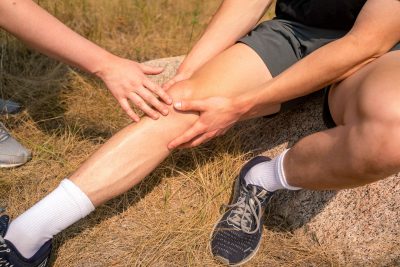Live Your Best Life

Get back to what you love. Our legendary care will help you get back to enjoying your favorite hobbies and more.
Schedule an appointment today with one of our JRMC Orthopedic providers to discuss options that would be the best fit for you.
Your joint replacement need-to-know
What is arthritis?
Rheumatoid arthritis and osteoarthritis are the two main types of arthritis. Rheumatoid arthritis is an autoimmune disorder where your own body attacks and wears down cartilage in your joint. Osteoarthritis or “wear and tear” arthritis occurs as the cartilage in your joint wears away over time from use. These conditions can lead to a total joint replacement.
Why does my joint hurt?
Cartilage serves as a cushion or liner. It keeps the bones in your joint from rubbing against each other to allow for a smooth and painless motion. When cartilage is no longer present or there isn’t enough, the bones rub against each other causing friction and pain with motion. The more active you are the more pain you experience.
What is a total joint replacement or arthroplasty?
A total joint replacement or arthroplasty is a surgery where an orthopedic surgeon removes the worn out joint and replaces it with an artificial joint generally made of titanium, cobalt chrome ally or polyethylene.
How successful will this surgery be?
The success of this surgery depends on many factors including severity of the arthritis before the surgery, adherence to doctor’s orders and your activity level after surgery. Physical therapy exercises before and after surgery will increase your chance of success. High impact activities will decrease the life of your joint. The success of your surgery depends mostly on you.
How do I know when I’m ready for this surgery?
Your doctor will tell you when your condition warrants an operation by looking at your x-rays, motion, stiffness and pain. You will decide when conservative or non-surgical measures are no longer allowing you to have the quality of life that you desire. It is a very personal and individual decision.
Am I too old or young for this surgery?
As long as you are in reasonable health at the time of the surgery, age generally isn’t a factor. If pain, stiffness and lack of mobility are affecting your quality of life, general health or job, then it may be time to look at surgical options.
How long will this joint replacement last and can a second replacement be done?
The life expectancy of a joint replacement is 18-20 years, but it depends on many factors. Patient’s age, weight, activity level and medical condition can affect the life of your joint. Joint replacements are medical devices or implants that may fail and need to be replaced. Certain parts may loosen or wear out and need to be replaced in the future. It is very important to follow your doctor’s recommendations after surgery.
What are the risks of a joint replacement?
There are two main complications or risks after a joint replacement: infection and blood clots. Nerve damage can also occur; however it is rare. We go to great measures to prevent these complications. You will receive antibiotics before and after your operation. As additional prevention efforts, our goal is to have you walking the day of surgery and be prescribed a blood thinner to prevent blood clots.
Do I need to exercise before surgery?
Yes. You will be given in-depth instructions with pictures of the exercises that you need to do before and after your operation. You need to become familiar with these and start them as soon as you schedule your operation. Exercise will ensure the best possible outcome of your surgery and will make rehabilitation easier.
What if I live by myself?
Our goal is get you home after surgery. You have several options available and these will be explored with your case manager/social services. Please ask a relative or a friend to help you or stay with you for 3-4 days at home. You can have home care come to your home and/or use other community services. You may also qualify to go to a skilled facility for a short time until you are able to care for yourself at home.
Do I need to go to sleep for this surgery?
You have the option of general or spinal anesthesia. The anesthesia department will visit with you about both options and help you decide which one will be best for you.
Will I have discomfort?
Yes. To expect to be pain free is unrealistic. You had discomfort before your operation and will have discomfort immediately after your surgery. The difference is, the pain you experienced before surgery would only have gotten worse. The discomfort after surgery, though different and more severe, will go away. By using the 0-10 pain scale we can determine a pain medication therapy and its effectiveness.
Will I need to walk with some type of assistive device?
Yes. You will need to use a front wheeled walker initially after surgery for several weeks. Regardless of age, you have been through a major operation. Your muscles need time to strengthen and you need time to adapt to your new joint. Safety first! We will work with you and help you obtain an assistive device that is safest for you. You may also need crutches, a toilet seat riser, tub bench or shower chair. You can check into loan closets or borrow items from friends and family.
Do I need physical therapy after I leave?
Patients that have had joint replacements do need physical therapy after discharge. Most patients will go to an outpatient setting. Others may need therapy at home or at a skilled facility. Your surgeon and physical therapist will decide how long you need to participate in outpatient physical therapy. You must continue your exercises twice a day at home for the first six months.
Where do I take paperwork that I need for insurance and/or work needs?
All paperwork must be dropped off and picked up at the JRMC Clinic.
When will I see the doctor after discharge?
- One week after surgery, the orthopedic team will remove dressings and assess the incision.
- Two weeks post-op, you will be seen for staple removal.
- Six week post-op, you will be seen for continued physical therapy follow-up, and additional x-rays.
- Twelve weeks post-op, there will be a final assessment to celebrate your success!
What activities can I do after my joint replacement?
You can engage in low impact activities as directed by your surgeon. Such activities include the home program outlined in this guide, regular 1-3 mile walks, walking on a treadmill, using a stationary bike, gardening, dancing and sports such as golf or bowling.
What will my activity restrictions be?
Low impact activities are best for the health of your joint. High impact activities such as running or tennis should be avoided to reduce the load on your new joint. High-risk activities such as downhill skiing are also discouraged due to fracture risks and possible damage to your new joint. Discuss higher impact activities at your six week appointment.
Will the joint feel different than my old one?
For most patients, the only differences are improved motion and no pain. For some, there might be slight leg length difference. Your surgeon will try to make your leg length as equal as possible. Most people get used to this over time or can use an insert in their shoe. You may notice a clicking noise when you walk, which is normal. Small nerves on the surface of the skin are damaged when an incision is made. This may lead to some numbness around the incision.
How long until I am able to drive?
Consult with your physical therapist on the types of movement in which you can engage. You should not drive for the first four to six weeks following surgery.
THE FOLLOWING PROVIDERS CAN HELP YOU WITH YOUR JOINT REPLACEMENT

The appointment you are making is with a Jamestown Regional Medical Center provider.

The appointment you are making is with a Jamestown Regional Medical Center provider.

The appointment you are making is with a Jamestown Regional Medical Center provider.

The appointment you are making is with a Jamestown Regional Medical Center provider.


